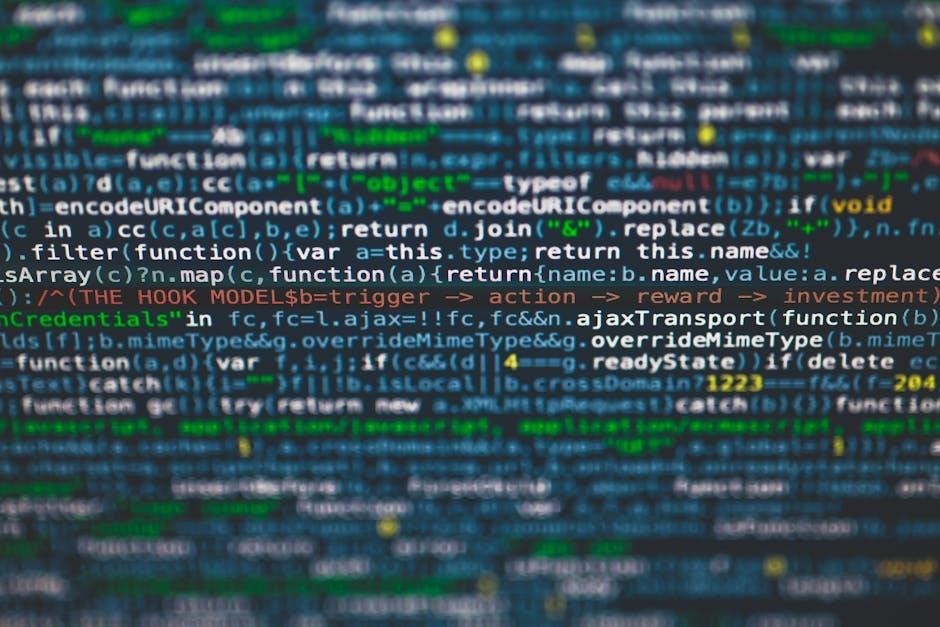Critical diagnostic signals from the chiller’s control system‚ Carrier chiller alarm codes indicate faults or irregularities‚ ensuring timely maintenance and efficient operation. Essential for quick issue resolution.
1.1 What Are Carrier Chiller Alarm Codes?
CARRIER chiller alarm codes are diagnostic signals generated by the chiller’s onboard control system to indicate faults or abnormal conditions. These codes alert operators or maintenance personnel to issues requiring attention‚ ranging from minor warnings like temperature fluctuations to critical system failures. Each code corresponds to specific problems‚ such as sensor faults‚ compressor issues‚ or refrigerant system malfunctions. For example‚ codes like T057 or TH-01 indicate particular faults‚ guiding technicians to the root cause.Displayed on the control panel or digital interface‚ these codes help identify and resolve issues quickly‚ minimizing downtime and ensuring efficient HVAC operation. Referencing official Carrier manuals or PDF guides provides detailed explanations for each code‚ essential for accurate troubleshooting and maintenance.
1.2 Importance of Understanding Alarm Codes
Understanding Carrier chiller alarm codes is crucial for ensuring optimal system performance‚ safety‚ and reliability. These codes provide clear indicators of potential issues‚ enabling timely troubleshooting and repairs. Ignoring or misinterpreting codes can lead to system failures‚ increased energy consumption‚ or even safety hazards. By recognizing and addressing alarm codes promptly‚ technicians can prevent minor issues from escalating into costly repairs. Additionally‚ understanding these codes enhances diagnostic efficiency‚ reduces downtime‚ and ensures compliance with maintenance standards. For HVAC professionals‚ familiarity with Carrier chiller alarm codes is essential for delivering effective service and maintaining customer satisfaction. Regular training and reference to official Carrier PDF guides can significantly improve proficiency in handling these codes effectively.

Common Carrier Chiller Alarm Codes
Carrier chiller systems display specific alarm codes to indicate operational issues. These codes range from critical faults to warning alerts‚ each signaling distinct problems like sensor malfunctions or pressure imbalances. Understanding these codes is essential for quick troubleshooting and maintaining system efficiency. Referencing official Carrier PDF manuals ensures accurate diagnosis and repair procedures.
2.1 Critical Alarm Codes (A140‚ A152‚ T114‚ T115‚ T116‚ T117‚ T133)
Critical alarm codes such as A140‚ A152‚ T114‚ T115‚ T116‚ T117‚ and T133 indicate severe issues requiring immediate attention. A140 typically signifies low condenser water flow‚ while A152 points to high condenser water temperature. T114 and T115 relate to evaporator sensor faults‚ and T116 and T117 often indicate condenser sensor issues. T133 may signal a compressor discharge temperature alarm. These codes highlight potential system failures if left unaddressed. Referencing the Carrier chiller alarm codes PDF manual is crucial for precise troubleshooting steps. Regular maintenance‚ such as sensor calibration and water flow checks‚ can prevent these critical alarms. Always consult a certified technician for complex repairs to ensure system safety and performance.
2.2 Warning Codes and Their Meanings
Warning codes in Carrier chiller systems indicate potential issues that may not immediately disrupt operation but could escalate if ignored. These codes often relate to temperature‚ pressure‚ or sensor anomalies. For example‚ codes like L141 or L142 may signify low or high refrigerant pressure‚ while L143 could indicate a condenser water temperature that’s out of range. Other warnings might involve sensor inaccuracies or communication faults. Addressing these early can prevent system shutdowns or damage. The Carrier chiller alarm codes PDF provides detailed explanations for each warning‚ helping technicians identify root causes. Regular checks‚ such as verifying sensor calibration and refrigerant levels‚ can often resolve these issues before they become critical.

Troubleshooting Carrier Chiller Alarm Codes
Troubleshooting involves systematic evaluation of alarm codes‚ checking sensors‚ and verifying system components like compressors and condensers. Always refer to the Carrier chiller alarm codes PDF for guidance.
3.1 Systematic Approach to Diagnostics
A systematic approach to diagnosing Carrier chiller alarm codes involves identifying the code‚ understanding its meaning‚ and following a structured troubleshooting process. Start by consulting the Carrier chiller alarm codes PDF to decode the specific issue. Next‚ inspect system components such as sensors‚ compressors‚ and condensers for faults. Verify wiring connections and ensure proper communication between control panels. Use diagnostic tools like the Pro-Dialog system to monitor real-time data and isolate the problem. Always follow safety protocols when handling electrical and refrigerant systems. By methodically addressing each potential cause‚ technicians can efficiently resolve issues and restore system performance. This approach minimizes downtime and ensures accurate repairs‚ adhering to manufacturer guidelines.
3.2 Resetting Alarm Codes: A Step-by-Step Guide
Resetting Carrier chiller alarm codes requires a precise approach to ensure system stability. Begin by identifying the specific alarm code using the Carrier chiller alarm codes PDF to understand its cause. Access the chiller’s control panel and navigate to the alarm reset function‚ typically found in the diagnostic or maintenance menu. Press and hold the reset button or follow the on-screen instructions to clear the code. Power cycle the system by turning it off and on to confirm the reset. If the alarm persists‚ refer to the PDF guide for troubleshooting steps. Always document the alarm code and reset process for future reference. This method ensures safe and effective resolution of alarm conditions. Proper reset procedures prevent recurring issues and maintain optimal system performance. Regularly review the alarm codes PDF for updated reset procedures.

Maintenance Tips to Prevent Alarm Codes
Regular system checks‚ cleaning filters‚ and ensuring proper refrigerant levels help prevent alarm codes. Schedule routine maintenance to maintain optimal performance and avoid potential issues.
4.1 Cleaning Filters and Condenser Coils
Cleaning filters and condenser coils is essential for maintaining chiller efficiency and preventing alarm codes. Dirty filters restrict airflow‚ causing increased pressure and potential system overloads. Condenser coils should be inspected and cleaned regularly to ensure proper heat transfer. Use a soft brush or compressed air to remove dirt and debris. For more stubborn buildup‚ a mild detergent and water solution can be applied‚ but ensure all electrical components are protected. Regular cleaning reduces the risk of alarms related to high pressure‚ overheating‚ or reduced performance. Refer to the Carrier Chiller alarm codes PDF for specific maintenance intervals and cleaning procedures. Neglecting these tasks can lead to recurring faults and system downtime.
4;2 Regular System Checks and Preventative Maintenance
Regular system checks and preventative maintenance are crucial for minimizing Carrier chiller alarm codes. Schedule periodic inspections of refrigerant levels‚ electrical connections‚ and compressor function. Lubricate moving parts and ensure proper alignment of motors and fans. Inspect pressure transducers and sensors for accuracy‚ as faulty readings can trigger alarms. Check for refrigerant leaks‚ which can lead to low-pressure alarms. Maintain proper water flow rates in condensers and evaporators to prevent temperature-related issues. Log all maintenance activities to track system performance over time. Address minor issues promptly to avoid escalation. Refer to the Carrier Chiller alarm codes PDF for recommended maintenance intervals and procedures. Consistent upkeep ensures reliable operation and reduces downtime due to unexpected faults.

Carrier Chiller Alarm Code PDF Resources
Carrier Chiller alarm code PDF resources are available on the official Carrier website‚ offering comprehensive guides‚ troubleshooting manuals‚ and detailed explanations for HVAC professionals.
5.1 Where to Find Official Carrier Chiller Manuals
Official Carrier chiller manuals‚ including alarm code PDFs‚ can be found on the Carrier Corporation website under the support or resources section. These manuals are designed to provide detailed troubleshooting guides‚ alarm code explanations‚ and system operation instructions. Additionally‚ authorized Carrier distributors and HVAC supply stores often offer access to these PDF resources. The manuals are typically available for download after creating a user account or by contacting Carrier’s customer support directly. They include comprehensive information on alarm code meanings‚ system diagnostics‚ and maintenance procedures‚ making them indispensable for technicians and facility managers. Always ensure to use the latest version of the manual for accurate and up-to-date information.
5.2 Comprehensive Guides for HVAC Professionals
Comprehensive guides for HVAC professionals on Carrier chiller alarm codes are available through Carrier’s official website and authorized distributors. These guides are designed to provide in-depth technical information‚ including advanced diagnostic techniques and troubleshooting strategies. They often include detailed explanations of alarm codes‚ system operation‚ and maintenance procedures. Additionally‚ these resources may cover case studies‚ best practices‚ and compliance standards. Many guides are tailored to specific chiller models‚ ensuring precise and relevant information. HVAC professionals can also access these materials through industry forums‚ training programs‚ and Carrier-certified workshops. These comprehensive guides are essential for optimizing chiller performance‚ resolving complex issues‚ and ensuring system reliability. They are a valuable resource for technicians aiming to enhance their expertise in Carrier chiller systems.

Advanced Diagnostic Techniques
Advanced diagnostic techniques involve using control panels‚ digital interfaces‚ and sensor data to identify complex issues. These methods enable precise fault detection and correction‚ optimizing system performance and reliability.
6.1 Using Control Panels and Digital Interfaces
Advanced diagnostics often begin with control panels and digital interfaces‚ which provide real-time insights into system performance and alarm statuses. These tools allow technicians to monitor operational parameters‚ access detailed logs‚ and interpret alarm codes effectively. By leveraging digital interfaces‚ professionals can pinpoint issues quickly‚ reducing downtime. Many modern Carrier chiller systems feature user-friendly control panels that display critical data‚ such as temperature‚ pressure‚ and flow rates‚ enabling precise troubleshooting. Additionally‚ these interfaces often support remote monitoring‚ allowing for proactive maintenance and faster resolution of alarm conditions. Regular training on these systems ensures technicians can maximize their diagnostic capabilities;

6.2 Interpreting Sensor Faults and Pressure Transducer Issues
Sensor faults and pressure transducer issues are common triggers for Carrier chiller alarm codes‚ often indicating system performance deviations. Sensors monitor critical parameters like temperature‚ pressure‚ and flow rates‚ while transducers convert these measurements into electrical signals. Faults in these components can lead to inaccurate readings‚ causing alarms to activate. Technicians should check for loose connections‚ wiring issues‚ or damaged sensors. Pressure transducer problems may arise from blockages‚ contamination‚ or calibration errors. Addressing these issues involves recalibrating sensors‚ replacing faulty transducers‚ or cleaning obstructed lines. Proper interpretation of these faults is essential for accurate troubleshooting and preventing false alarms‚ ensuring optimal chiller operation and reliability.

Case Studies and Real-World Applications
Examine real scenarios where Carrier chiller alarm codes resolved issues like high discharge pressure or sensor faults‚ providing practical insights for technicians and operators.
7.1 Resolving Common Faults Like T057 in Air-Cooled Chillers
T057 is a common fault code indicating high discharge pressure in Carrier air-cooled chillers. This issue often arises from condenser coil blockages‚ faulty fan motors‚ or refrigerant overcharge. Technicians should start by inspecting the condenser coils for dirt or debris and ensuring proper airflow. Next‚ they should check the fan motor operation and verify refrigerant levels. If the problem persists‚ reviewing the system’s pressure transducer calibration is essential. Corrective actions may include cleaning the condenser‚ replacing faulty fans‚ or adjusting refrigerant levels. Regular maintenance‚ such as filter cleaning and coil inspections‚ can prevent T057 from recurring. Addressing this fault promptly helps avoid compressor damage and ensures optimal chiller performance.
7.2 Addressing High Discharge Pressure and Compressor Overheating
High discharge pressure and compressor overheating are critical issues that can lead to system shutdowns and costly repairs. These problems often stem from blocked condenser coils‚ faulty fan motors‚ or low refrigerant levels. Technicians should first inspect the condenser for dirt or obstructions and ensure proper airflow. Next‚ they should check the fan motor operation and verify refrigerant levels. If the issue persists‚ replacing the thermal expansion valve or adjusting system parameters may be necessary. Regular maintenance‚ such as cleaning condenser coils and monitoring refrigerant levels‚ can help prevent these issues. Additionally‚ ensuring proper system sizing and airflow can reduce the risk of high discharge pressure and compressor overheating‚ promoting long-term reliability and efficiency.

Tools and Software for Alarm Code Analysis
Utilize diagnostic tools such as multimeters‚ pressure gauges‚ and temperature sensors. Software tools include alarm code analyzers‚ data loggers‚ and real-time monitoring platforms.
8.1 Pro-Dialog Control System for Chiller Management
The Pro-Dialog Control System is a cutting-edge tool designed for efficient chiller management. It offers advanced monitoring capabilities‚ enabling real-time tracking of system performance and alarm statuses. This system simplifies diagnostics by providing detailed insights into alarm codes‚ allowing technicians to identify and resolve issues swiftly. Its user-friendly interface ensures seamless navigation through system data‚ making it an essential resource for HVAC professionals.
Pro-Dialog also supports integration with Carrier chiller alarm code PDF resources‚ enabling quick access to troubleshooting guides and technical documentation. By leveraging this system‚ technicians can optimize chiller performance‚ reduce downtime‚ and ensure compliance with maintenance schedules. It’s a comprehensive solution for modern chiller management needs.
8.2 Touch Pilot System Functions and Capabilities
The Touch Pilot system is an intuitive interface designed to enhance chiller management and alarm code analysis. It offers advanced functions such as real-time monitoring‚ diagnostics‚ and control of chiller systems. Technicians can access detailed alarm code explanations‚ historical data‚ and performance metrics through its user-friendly touch-screen interface.
One of its key capabilities is the ability to integrate with Carrier chiller alarm code PDF resources‚ providing instant access to troubleshooting guides. The system also supports remote monitoring‚ enabling proactive maintenance. Its advanced analytics and customizable alerts ensure optimal system performance and minimize downtime‚ making it a vital tool for HVAC professionals managing complex chiller systems.
Training and Certification for Technicians
Carrier offers specialized training programs for technicians‚ focusing on chiller systems and alarm code diagnostics. These courses enhance technical skills and ensure effective alarm code troubleshooting and system maintenance.
9.1 Courses for Mastering Carrier Chiller Systems
Carrier offers comprehensive training courses designed to help technicians master chiller systems‚ including alarm code diagnostics. These programs cover theoretical and practical aspects‚ ensuring technicians can interpret and resolve issues efficiently. The curriculum includes hands-on labs‚ real-world simulations‚ and access to official Carrier Chiller Alarm Code PDF resources. Participants learn to identify root causes of alarms‚ perform systematic troubleshooting‚ and implement preventative measures. Advanced courses also focus on system optimization‚ energy efficiency‚ and safety protocols. By completing these certifications‚ technicians gain expertise in managing chiller performance‚ reducing downtime‚ and enhancing overall system reliability. These courses are essential for professionals aiming to excel in HVAC maintenance and service industries.
9.2 Best Practices for Service and Maintenance
Regular maintenance is crucial for minimizing chiller downtime and preventing alarm codes. Technicians should follow a structured routine‚ including filter cleaning‚ coil inspections‚ and refrigerant level checks. Referencing the Carrier Chiller Alarm Code PDF ensures accurate diagnosis and repair. Always perform pre-service checks‚ such as verifying system power and safety controls. Documenting maintenance activities helps track system health and identify recurring issues. Use genuine Carrier parts for replacements to maintain performance and warranty compliance. Train personnel on updated protocols and tools‚ like the Pro-Dialog control system. Schedule annual professional inspections to address hidden faults. By adhering to these best practices‚ technicians can optimize chiller efficiency‚ reduce operational costs‚ and extend equipment lifespan. Consistency and attention to detail are key to reliable system operation.

Frequently Asked Questions (FAQs)
- What do Carrier Chiller alarm codes indicate? They signal system issues‚ such as sensor faults or pressure imbalances‚ requiring immediate attention to prevent equipment damage.
- Where can I find the Carrier Chiller alarm code PDF? Official manuals are available on Carrier’s website or through authorized distributors for detailed code explanations and troubleshooting guides.
- How do I reset a chiller alarm? Refer to the alarm code PDF for specific reset procedures‚ ensuring safety and proper system operation after addressing the underlying issue.
- Can I resolve all issues without professional help? Minor issues may be fixable‚ but critical faults require trained technicians to avoid further damage or safety hazards.
10.1 Common Queries About Alarm Codes and Troubleshooting
Users often ask about interpreting Carrier Chiller alarm codes and resolving issues efficiently. Common questions include: “What does a specific alarm code mean?” and “How can I troubleshoot the system effectively?” Many seek guidance on locating the official Carrier Chiller alarm code PDF‚ which provides detailed explanations and solutions. Others inquire about the difference between critical alarms and warnings‚ as well as the best practices for resetting codes without causing further damage. Additionally‚ there are questions about preventing recurring issues and understanding when professional assistance is necessary. These queries highlight the importance of proper training and access to reliable resources for effective chiller maintenance and troubleshooting.
10.2 Solutions for Persistent or Recurring Issues
For persistent or recurring issues with Carrier Chiller systems‚ it’s essential to identify the root cause. Start by reviewing the alarm history in the Carrier Chiller PDF to understand patterns. Check for sensor accuracy‚ as faulty sensors can trigger repeated alarms. Ensure proper airflow and verify refrigerant levels‚ as imbalances can cause system instability. Clean condenser coils and filters regularly to prevent overheating. If issues persist‚ consult the official Carrier Chiller manual for advanced troubleshooting steps or contact certified technicians. Regular maintenance‚ as outlined in the PDF‚ can significantly reduce recurring problems and ensure optimal system performance.
